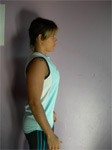Core Exercises
Most of us have a lifestyle that doesn't neccesarily support our bodies' needs and this can leave us with an unactivated, untoned midrift we'd like to change. Its 50% good nutrition and 50% activation of the deeper and superficial abdominal muscles that will allow this change. So here's a couple of solutions for the latter part of the equation that you can do at home.
Simple exercises to achieve a leaner middle
1) The 'drawing in' manouvre
This is a stabilisation exercise that focuses on the ACTIVATION of the transverse abdominals - knows as your TVA. The transverse abdominals are a ring of muscle that sits around your lower spine like an internal corset and plays a vital role in protecting the lumbar (lower) spine from damage. This exercise is simple and designed to be done anytime! Especially when you find yourself in a sedentary position for more than 30 mins, (sitting at a desk or in a car!)

- Take a breath in and as you do, draw your belly button in towards spine
- You should feel a tension develop in your midrift (like you have put a belt on!)
- As you breath out, keep your belly button drawn towards your spine
- Then breath normally
Hold the tension for as long as you remember, although it wont be long to start with. The more you practice this manouvre the more automatic it will become. By strengthening your TVA and retraining it to automatically activate and stay where it should, you can visibly reduce the size of your waist as well as protecting your lumbar spine in the long-term. Do it as often as you remember, no one will even know when your doing it! Once you can activate these muscles and it's a regular habit, add in the next exercise.
2) Opposite arm & leg crunches
This exercise activates the lower, middle and the upper portion of the abdominals and so is a fantastic exercise for achieving an improvement in muscle tone. However, it is a test of co-ordination and should only be attempted if you are able to do the drawing in manouvre effectively.
- Firstly, activate your core muscles using the drawing-in manouvre before you start the exercise
- Your start position should resemble that of a 'dead fly' with you lying on your back with your legs and arms up in the air.
- Legs can be slightly bent (relative to hamstring flexibility) but need to be at 90 degrees to the hips. If the legs are not brought in enough towards the centre of the body you can end up activating your lower back muscles which is not the aim of the exercise.
- Slowly take one arm and the opposite leg outwards away from the body and down to towards the floor (see figure A).
IMPORTANT: the range of movement is determined by the individual's level of core strength so start SMALL!

- Keep drawing-in as you lower your opposite arm and leg, you will reach a point that feels like clutch control on a car where, if you go any further, the activation may go into your back - DON'T go past this point!
- Bring the limbs back to the middle and swap so the other arm and leg now follow the same pattern.
- The key to this exercise is keeping your core muscles doing the work and keeping the whole movement very slow and controlled!
- Aim to work up to 10-12 reps each side, with slow, controlled movement.
| Exercise | How long/many? | How often? |
|---|---|---|
| Drawing-in manouvre | As long as you remember |
As often as you remember |
| Opposite arm & leg crunches | Work up to 10-12 each side | 2-3 times a week, not on consecutive days |
Next time we'll focus on another body part, which will be the legs (and more specifically the gluteus maximus, medius and minimus) and look at ways you can make real changes in the comfort of your own home with minimal equipment.













